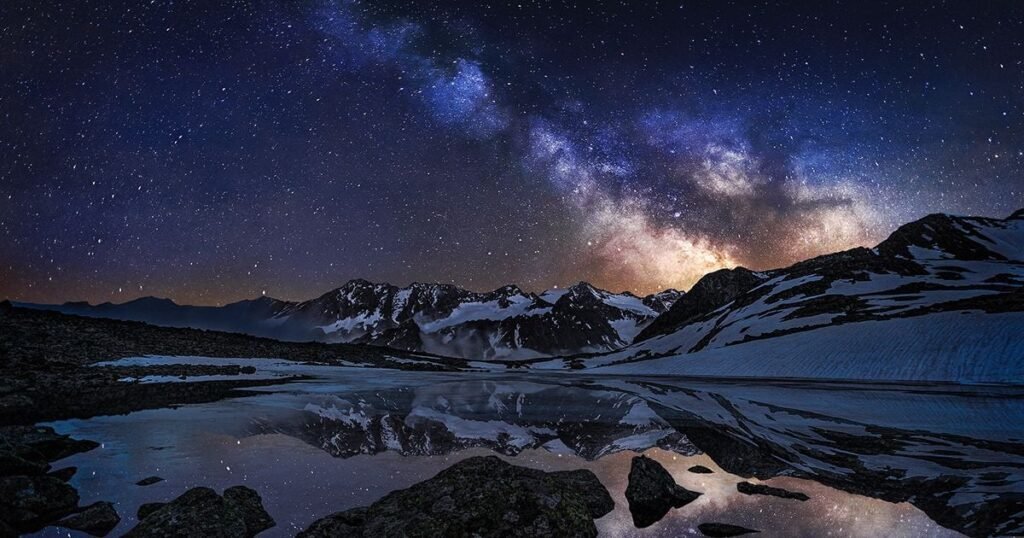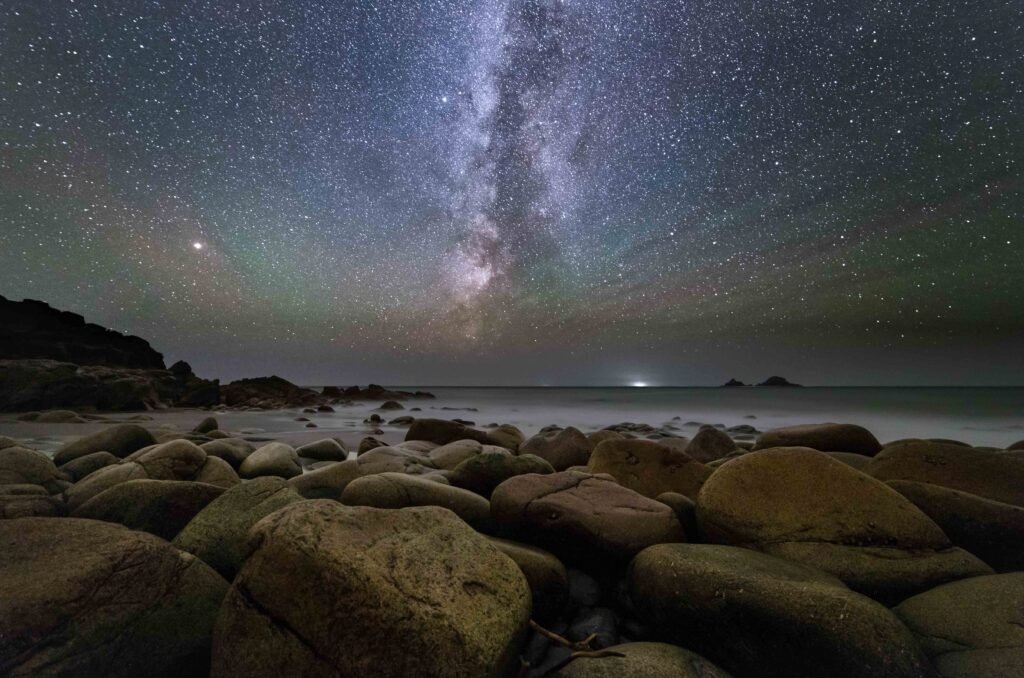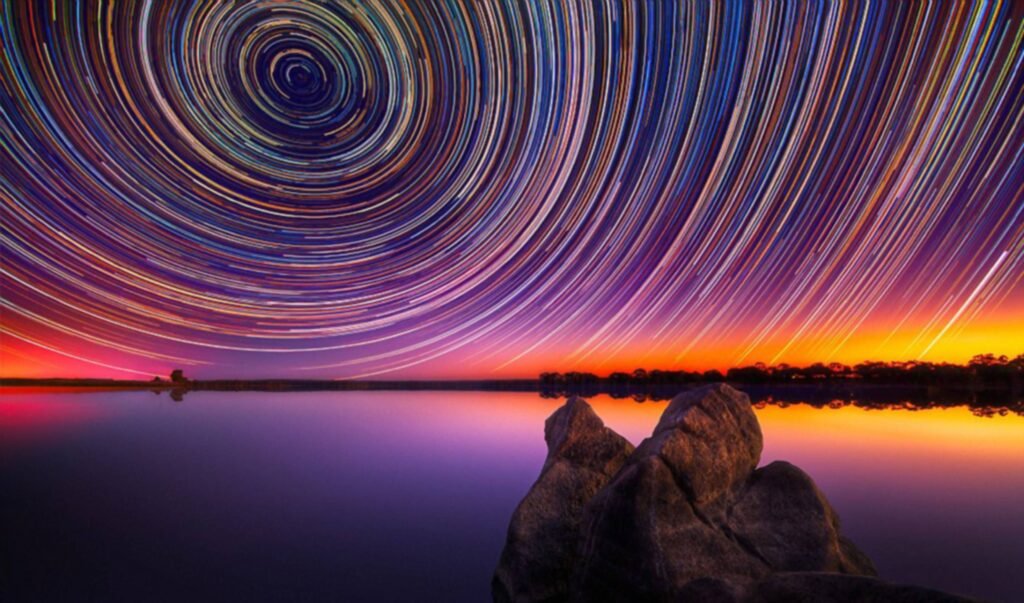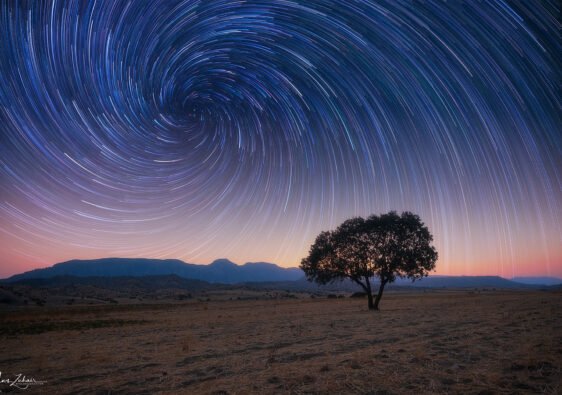
Introduction to Death Valley Stargazing
Death Valley National Park, renowned for its breathtaking landscapes and extreme conditions, stands out as one of the premier stargazing locations in the world. As a designated International Dark Sky Park, its vast, unspoiled expanses are dedicated to preserving the clarity of the nighttime sky. The park’s isolation, high elevation, and aridity are critical factors that contribute to the exceptional visibility of celestial objects, providing stargazers with an unparalleled opportunity to observe the wonders of the universe.
Situated in Eastern California, Death Valley is characterized by its intriguing terrain, which includes sand dunes, salt flats, and rugged mountains. These features add depth and contrast to the night sky, enhancing the stargazing experience. The park’s elevation, reaching up to 11,000 feet at Telescope Peak, allows for a clear vantage point above many atmospheric disturbances commonplace at lower elevations. Furthermore, the low humidity and minimal light pollution—thanks to its vast desert expanses—allow astronomers and casual observers alike to appreciate the brilliance of stars, galaxies, and other celestial phenomena. Have you been on the Death Valley Sunset and Stargazing Tour, click here to check it out.
The unparalleled beauty of the night sky is a significant draw for visitors. With thousands of stars visible to the naked eye, the park offers stunning opportunities to view constellations, meteor showers, and even the Milky Way in all its glory. Whether you are a seasoned astronomer equipped with telescopes or simply a curious traveler eager to gaze at the heavens, Death Valley provides an ideal setting to connect with the cosmos. As the sun sets and darkness envelops the park, the celestial canvas unfolds, making for an unforgettable stargazing experience that beckons visitors from around the globe.
Understanding the Night Sky



The night sky over Death Valley is a mesmerizing spectacle, characterized by the presence of countless celestial bodies. One of the most prominent features is the Milky Way, a vast galaxy that serves as the backdrop for many stargazing experiences. This barred spiral galaxy is not only home to our solar system but also harbors billions of stars, nebulae, and other astronomical wonders. Viewing the Milky Way from Death Valley, away from the light pollution of urban areas, allows enthusiasts to appreciate its breathtaking beauty, often appearing as a luminous band stretching across the sky.
Stargazers in Death Valley have the added benefit of witnessing various astronomical phenomena, including meteor showers. These events, occurring at specific times throughout the year, are caused by Earth passing through debris left by comets. Well-known meteor showers such as the Perseids and the Geminids can produce stunning displays, with multiple meteors appearing per hour under optimal conditions. Planning a stargazing trip during these showers provides visitors with the unique opportunity to observe “shooting stars” against the expansive night sky.
Moreover, the phases of the moon play a crucial role in enhancing or hindering the stargazing experience. A new moon, characterized by the absence of moonlight, creates ideal conditions for observing the subtle details of constellations and distant celestial objects. Conversely, a full moon, while beautiful, can drown out fainter stars and deep-sky objects with its brightness. Therefore, understanding moon phases is essential for anyone looking to optimize their stargazing experience in this remarkable desert environment.
Ultimately, appreciating the night sky over Death Valley requires both knowledge and planning, enabling visitors to make the most of their stargazing adventure when Mars meets the Milky Way.
The Importance of Dark Sky Parks
Dark sky parks play a crucial role in preserving the natural night environment, providing a sanctuary for stargazers to witness the breathtaking beauty of the cosmos. These parks are recognized for their exceptionally clear and dark skies, which are essential for optimal stargazing experiences. One notable example is Death Valley National Park, which has received a ‘gold tier’ designation from the International Dark-Sky Association (IDA).
The ‘gold tier’ classification signifies that Death Valley meets stringent criteria for sky quality, including low light pollution, excellent visibility of celestial bodies, and a commitment to environmental preservation. To attain this esteemed status, parks must demonstrate their dedication to reducing artificial light and educating the public about the significance of dark skies for both wildlife and human well-being. This commitment enhances the overall experience for amateur and seasoned stargazers alike, as they can enjoy unobstructed views of the Milky Way, planets, and other astronomical wonders.
Visiting a dark sky park such as Death Valley offers numerous benefits. Stargazers can engage in activities like astrophotography, learn about celestial navigation, and develop a deeper appreciation for the universe. The stark contrast between the brightness of celestial bodies and the darkness of the surroundings creates a magical atmosphere that allows for unparalleled observation of stars and other celestial phenomena. Moreover, these parks often host star parties and educational programs, fostering a community of astronomy enthusiasts.
In summary, the significance of dark sky parks like Death Valley cannot be overstated, as they provide a vital refuge for stargazers seeking to escape urban light pollution and immerse themselves in the wonders of the night sky. The ‘gold tier’ designation reinforces the park’s commitment to maintaining dark skies, ensuring that future generations can enjoy the awe-inspiring spectacle of the cosmos.
Best Stargazing Spots in Death Valley
Death Valley, renowned for its stark beauty and remarkable landscapes, provides an exceptional venue for stargazing enthusiasts. The park is designated as an International Dark Sky Park, meaning it offers some of the darkest skies in the United States, making it ideal for viewing celestial phenomena. Here are some of the top locations within Death Valley where visitors can immerse themselves in the grandeur of the night sky.
One of the most popular stargazing spots is Dante’s View. Situated at an elevation of over 5,000 feet, this viewpoint offers not only breathtaking panoramic views of the valley but also serves as a perfect platform for stargazing. The higher elevation significantly reduces light pollution, enhancing stargazers’ ability to observe constellations and celestial events. Accessibility is straightforward, as a paved road leads directly to the viewpoint, making it suitable for individuals with mobility challenges.
Another excellent location is Antelope Canyon, which presents a unique backdrop of rugged rock formations against the starry sky. While it is more accessible via hiking, the trail leads you through dramatic landscapes that are alive with color, especially during sunset. For those willing to walk a bit, the effort is rewarded with stunning views of the Milky Way overhead, particularly during the summer months, when conditions are optimal for sky gazing.
Finally, consider the Badwater Basin, the lowest point in North America. This flat expanse allows for unobstructed views of the horizon and provides an ethereal atmosphere for stargazing. With its salt flats reflecting starlight, the experience becomes almost otherworldly. Visitors should arrive well before sunset to fully appreciate the transition from twilight to the brilliance of the night sky. All these spots culminate in an unforgettable stargazing experience where the infinite cosmos meets the raw beauty of Death Valley.
Choosing the Right Time to Visit
For those planning a trip to Death Valley for an unforgettable stargazing experience, selecting the optimal time to visit is crucial. Several factors can significantly enhance the quality of your celestial views, including moon phases, seasonal variations, and astronomical events such as meteor showers.
One of the primary considerations when planning your visit is the lunar cycle. The presence of the full moon can diminish the visibility of celestial bodies due to increased brightness. Ideally, you should aim to plan your stargazing adventures during the new moon phase when the sky is darkest, thereby maximizing your chances of seeing stars, planets, and other astronomical phenomena clearly. Additionally, periods around the first and last quarter moons can offer a balance of both moonlight and dark skies.
Seasonal variations also play a key role in the overall stargazing experience. While Death Valley is known for its extreme temperatures, both summer and winter offer unique perspectives of the night sky. Winter months, specifically between November and March, often provide clearer air and less atmospheric turbulence. Conversely, summer months afford longer days but warmer temperatures at night, allowing for comfortable outdoor experiences. Therefore, balancing temperature preferences with sky clarity is essential for an optimal visit.
Furthermore, keep an eye on specific celestial events, such as meteor showers. Notable meteor showers, including the Perseids and Leonids, occur annually and can be spectacular sights in the clear skies of Death Valley. To ensure your visit coincides with these events, consult astronomical calendars to find dates when the visibility will be highest. By carefully considering these factors, your journey to Death Valley for stargazing will undoubtedly be a rewarding experience.
Accommodation Options for Stargazers
Death Valley, renowned for its serene landscapes and breathtaking night skies, offers a variety of accommodation options tailored to enhance the experience for stargazers. Visitors seeking an immersive experience can choose from a range of hotels, motels, and campgrounds equipped to provide exceptional views of the cosmos.
Firstly, the national park itself features several campgrounds, perfect for those who prefer a closer connection with nature. Campgrounds such as Furnace Creek and Mesquite Flat are equipped with amenities like restrooms and picnic tables, allowing visitors to enjoy a comfortable stay. The unique advantage of camping in these areas is the unobstructed views of the night sky, presenting an ideal setting for astronomy enthusiasts eager to observe stars, planets, and even the Milky Way in all its glory.
For those who prefer more structured accommodations, a selection of hotels and motels can be found within and around Death Valley. Properties like the Furnace Creek Ranch and the Stovepipe Wells Village Hotel offer various amenities, including outdoor lounges and telescopes that cater specifically to stargazers. Many hotels provide blackout curtains and strategically positioned outdoor seating, ensuring that guests can enjoy breathtaking celestial displays right from their rooms or balconies.
Additionally, for a unique experience, consider booking a stay in one of the more remote lodges, which often come with eco-conscious approaches to hospitality. These lodges typically offer spectacular views of the star-filled sky and can also arrange guided stargazing tours or provide telescopes for personal use. These accommodations not only prioritize comfort but also foster a deep appreciation for the natural beauty surrounding them. Here is my top 5 hotels near Death Valley Park.
- The Inn at Death Valley
- Quality Inn Lone Pine Near Mount Whitney
- Trails Motel
- Mount Whitney Motel
- Shady Lady Bed and Breakfast
In conclusion, whether camping under the stars or enjoying the comforts of a hotel, Death Valley provides numerous accommodation options that promise memorable experiences for all stargazing enthusiasts.
Tips for an Exceptional Stargazing Experience
To fully appreciate the beauty of the night sky while stargazing in Death Valley, it is essential to plan ahead and prepare adequately. An important first step is choosing the right accommodations that offer dark skies with minimal light pollution. Hotels and campgrounds located away from city lights will provide optimal conditions for viewing the stars. Make sure to check the listings that specifically mention their stargazing suitability.
Bringing proper gear is crucial for enhancing your experience. A comfortable reclining chair or blanket can enhance your stargazing comfort, allowing you to lie back and gaze up for extended periods. It’s also wise to layer clothing to accommodate fluctuating nighttime temperatures in Death Valley. Also, pack a flashlight with a red filter, as it preserves your night vision, enabling you to navigate your surroundings without compromising your viewing experience.
In addition to these essentials, consider investing in a good quality telescope or binoculars to see celestial objects in greater detail. Many hotels or organizations may offer equipment rentals; however, for the best experience, having your own gear can make a significant difference. Furthermore, mobile apps can greatly enrich the stargazing experience, as they allow you to identify constellations and planets in real-time. Popular applications such as SkyView or Stellarium are highly recommended for this purpose.
Finally, it is beneficial to check the weather conditions and moon phase ahead of time. Clear, dark nights without a bright moon are ideal for stargazing, as they allow for the visibility of fainter stars and celestial phenomena. Planning your trip around new moons can lead to a more rewarding experience. Being prepared and informed are key factors that can transform your stargazing adventure into a truly memorable exploration of the cosmos.
Photography Tips for Stargazers
Capturing the celestial beauty of Death Valley requires a meticulous approach to astrophotography. The stark and desolate landscape paired with vibrant night skies makes for a unique environment that encourages photographers to explore various techniques. First and foremost, one must choose the right equipment to achieve optimal results. A DSLR or mirrorless camera with manual settings allows greater control over exposure and focus. A wide-angle lens with a low f-stop, ideally between f/2.8 and f/4, is recommended to capture expansive views of the Milky Way while allowing more light to enter the lens.
Sturdy tripods are essential for astrophotography to ensure stability during long exposure shots, avoiding any unwanted blurs in your images. In Death Valley, using a remote shutter release can further minimize camera shake. When planning your photography session, aim for a location away from light pollution, ideally one of the many remote spots that the park offers. The darker the surroundings, the more compelling your night sky photos will be. Additionally, it’s vital to check weather conditions and moon phases; photographing on nights with little to no moonlight will accentuate the stars in your photographs.
Once you’ve captured your images, post-processing plays a crucial role in bringing your vision to life. Software such as Adobe Lightroom or Photoshop allows you to enhance colors, adjust contrast, and reduce noise. Techniques such as stacking images can help in achieving a more detailed and vibrant final product. Keep in mind that subtle adjustments can often yield the best results, allowing the natural beauty of the night sky to shine without overwhelming alterations. By adhering to these tips and techniques tailored specifically for Death Valley, you will undoubtedly enhance your stargazing photography experience.
Planning Your Trip to Death Valley
When planning a trip to Death Valley, especially for an extraordinary stargazing experience, there are several key considerations to ensure a successful visit. First and foremost, choosing the right time to visit is crucial to avoid crowds and enjoy the night sky. The optimal months for stargazing generally fall between September and April. During this period, temperatures are cooler, making nighttime viewing much more comfortable. Furthermore, visiting during a new moon phase will enhance your stargazing experience by minimizing natural light interference, allowing for clearer visibility of celestial bodies.
Driving routes into Death Valley are straightforward, with the main thoroughfare being California State Route 190. If you are coming from major cities such as Las Vegas or Los Angeles, plan ahead for rest breaks or overnight stays along the route, as this will help you better enjoy the scenic landscapes leading into the park. It’s wise to fill your gas tank before entering the valley, as fuel stations are sparse within the national park.
Permits are required for specific activities, such as camping in designated areas or using certain photography equipment. Familiarize yourself with the national park’s regulations prior to your visit. Camping permits can be acquired at the visitor center, ensuring you comply with local guidelines while immersed in nature’s beauty. Additionally, ensure your vehicle is well-prepared for the journey, considering the rugged terrain and varying weather conditions.
Lastly, while planning your stargazing adventures, factor in some background research on the best stargazing spots within Death Valley. Locations such as Dante’s View and Badwater Basin are particularly renowned for their breathtaking views of the night sky. By meticulously planning your visit to Death Valley with these aspects in mind, you can maximize your enjoyment of the park’s stunning stargazing opportunities.
The Night Shift
When the last day-hiker has packed up and the final RV has settled in for the night, Death Valley transforms. The desert that scorches during the day becomes a portal to the universe after dark. Here, far from the glow of civilization, you’ll discover what our ancestors saw every night—a sky so dense with stars it seems solid, where the Milky Way casts actual shadows and meteors streak so frequently you’ll stop making wishes.
In Death Valley, you don’t just look at the stars. You become part of them. The same minerals that make this desert floor sparkle in daylight—salt, borax, and countless others—are forged in the nuclear hearts of distant suns. Standing on this ancient lakebed under infinite darkness, you’re literally made of stardust standing on stardust, watching your cosmic siblings dance overhead.
Pack light, but bring wonder. Death Valley’s night sky doesn’t just change your perspective—it changes you.




[…] 2. Death Valley National Park, California/Nevada […]